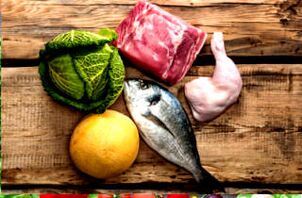The keto diet is not a popular diet. However, it is similar to many other more common nutritional systems: Atkins, Dukan and others. All of these diets are low in carbohydrates. They involve the almost complete rejection of carbohydrates in the daily diet. It is very effective for weight loss and burning subcutaneous fat. Even more pounds of liquid in front of your eyes! In addition, the keto diet is a favorite among athletes because it allows you to lose weight without sacrificing muscle mass.
Principles of diet
Today, our diets are too saturated with carbohydrates, especially fast ones. Bread, chips, snacks, bars - these products for snacks on the run are a real carb time bomb. This style of diet not only gives excess weight, but also contributes to the development of diabetes, atherosclerosis. Excess carbohydrates quickly slow down metabolism, cause lethargy, drowsiness.
However, the useful slow carbohydrates contained in grains contribute to weight gain. The problem is that any carbohydrate, when ingested, is converted into glucose, which is needed for energy.
How does a keto diet work? With significant restrictions on carbohydrate intake, the body’s mode of operation is rebuilt. Nature has created reserve mechanisms to obtain energy for important processes. If the amount of glucose obtained from carbohydrates in the diet approaches zero, the body begins to produce it, breaking down fat stores. This process is called ketosis, hence the name of the diet: ketone or ketogenic.
Instructions for proper menu preparation
To properly compile a menu for a ketone diet, you need to work a little. First of all, you need to calculate your daily calorie intake. This can be done online with the help of special programs.

After determining your daily calorie intake, it is important to choose a keto diet goal. To lose weight, you need to subtract 500 kcal from the resulting figure, to gain muscle mass, add 500 kcal.
Then we calculate the daily amount of protein, fat and carbohydrates needed. Carbohydrates should be no more than 10%, you should try to get the calories lost not at the expense of fat, but at the expense of protein. It sounds a bit complicated, but then again, with the help of an online food diary, anyone can control the KBJU ratio in the diet.
Let's give an example of a calculation. A woman weighing 60 kg, the fat percentage is 20 (you can determine the fat percentage visually or using a special analyzer). Daily calorie intake is 2000. For weight loss, minus 500, we get 1500 kcal per day. We count BJU. For 1 kg of muscle mass, you need 2. 2 g of protein (4 kcal), 0. 4 g of carbohydrates (4 kcal), the remaining kilocalories are left for fat at the rate of 9 kcal per 1 g of fat. So, 60 kg - 20% = 48 kg of muscle mass.
Protein 2. 2 * 48 = 106 g (424 Kcal)
Carbohydrate 0. 3 * 48 = 19 g (76 Kcal)
1500-424-76 \ u003d 1000 kcal, that is, about 110 g of fat per day.
Simplified instructions
Adhering to the formula for calculating the menu is necessary for people whose lives are related to exercise. For people away from sports, there are easier options for prescribing a diet on a ketogenic diet. There are two lists - these are recommended and prohibited products.

Recommended products:
- meat
- Birds
- fish
- dairy
- nuts
- Cheese
- Vegetables (except potatoes, beets and beans)
prohibited:
- Any sweets, incl. sugar
- Bakery Products
- Pasta
- Fruits, incl. dried fruits
- grain
On a keto diet, you need to monitor the amount of carbohydrates in the food. This information can be obtained from the product packaging (if it is a finished food product) or see the nutrition table. In general, you should give preference to products that contain no more than 10 g of carbohydrates per 100 g. According to this rule, it is quite easy to make a list of products to buy and develop a menu for a week.
Example of a keto diet menu

Option 1:
- Breakfast: omelet with cheese.
- Lunch: vegetable soup with chicken broth, a slice of rye bread.
- Afternoon snack: yogurt.
- Dinner: boiled beef, fresh vegetable salad.
Option 2:
- Breakfast: cottage cheese with sour cream.
- Lunch: boiled chicken breast with buckwheat.
- Afternoon snack: nuts.
- Dinner: salmon with vegetables, baked in foil.
During the day, you need to drink enough water (about 2 liters a day). Tea and coffee without sugar are allowed. In addition, it is recommended to eat fiber to normalize the digestive process.
Contraindications
A low -carbohydrate diet is dangerous because of its burden on the liver, kidneys and cardiovascular system. So for people who have some problems with these organs, a keto diet is contraindicated. Also, people with constipation and other digestive problems should not follow a ketogenic diet. Healthy people need to take vitamin and mineral complex supplements during the keto diet.
Effects of ketone diet
Reviews and results suggest that only the first 3-4 days are difficult for a keto diet. Currently, the body is reorganizing to a ketogenic regime, so you may experience a feeling of weakness, dizziness. In the future, these negative effects disappear, and the fat burning process begins. To get good results, the diet must be followed for at least 3 weeks.
Those who have been on a ketogenic diet note that there is no feeling of hunger. In addition, at the end of the diet, the craving for sugar decreases. The body gets used to sugar -free during the diet, which helps develop healthy eating habits. If you look at photos of people before and after the diet, you can notice the appearance of relief in the body. This is especially evident in those who do not forget physical exercise. The ketone diet is perfect for athletes, as well as anyone who wants to have a slim body!






























